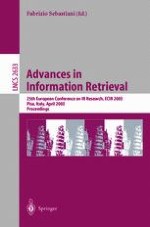The European Conference on Information Retrieval Research, now in its 25th “Silver Jubilee” edition, was initiallyestablished bythe Information Retrieval Specialist Group of the British Computer Society(BCS-IRSG) under the name “Annual Colloquium on Information Retrieval Research,” and was always held in the United Kingdom until 1997. Since 1998 the location of the colloquium has alternated between the United Kingdom and the rest of Europe, in order to re?ect the growing European orientation of the event. For the same reason, in 2001 the event was renamed “European Annual Colloquium on Information Retrieval Research.” Since 2002, the proceedings of the Colloquium have been published bySpringer-Verlag in their Lecture Notes in Computer Science series. In 2003 BCS-IRSG decided to rename the event “European Conference on Information Retrieval Research,” in order to re?ect what the event had slowly turned into, i.e., a full-blown conference with a European program committee, strong peer reviewing, and a (mostly) European audience. However, ECIR still retains the strong student focus that has characterized the Colloquia since their inception: student fees are kept particularlylow, a s- dent travel grant program is available in order to encourage students to attend the conference (and encourage student authors to present their papers pers- ally), and a Best Student Paper Award is assigned (conversely, ECIR has no best paper award).
